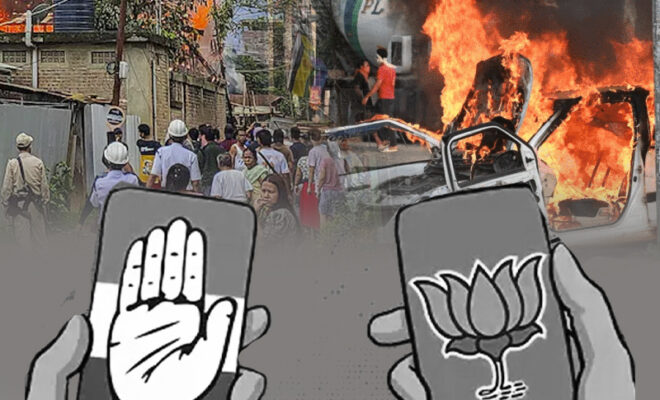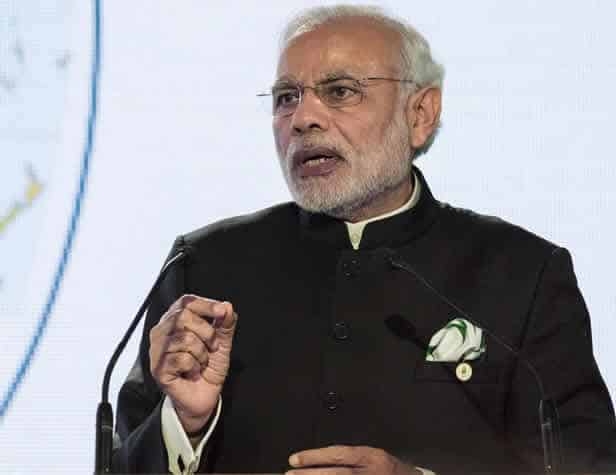Who Gains from the Spread of Hate?

When the Bharatiya Janata Party (BJP) was in power, it was said that there were no communal riots. That claim is false in light of the racial unrest that occurred in BJP-run Manipur and Haryana, respectively.
The conflict between “ethnic” communities in Manipur has quickly taken on the appearance of a Hindu-Christian conflict. The violent criminals among the Muslims of Nuh in the Mewat region of Haryana, where the violence began, do not have a sterling reputation; they have progressed from cattle rustling to cybercrime. They assert that two videos released by Bajrang Dal and cow vigilante activists incited them. The videos urged Hindus to participate in a religious procession on Monday in Nuh and pay a lot of attention to the temples in Mewat. The Muslim community allegedly became enraged by the videos and gathered in large numbers on July 31 to interfere with the procession.
Who Gains from the Spread of Hate?
Who lit the communal fuse can only be determined through a thorough investigation, but who does a heightened communal atmosphere benefit? The query is equally pertinent in Manipur and Haryana.
Despite the complete breakdown of law and order in the state, the conflict in Manipur has rendered BJP Chief Minister N Biren Singh virtually untouchable. He has successfully rallied the Meitei Hindus to his cause. In 2002, former Prime Minister Atal Bihari Vajpayee gave him advice to follow “Raj Dharma,” but Prime Minister Narendra Modi cannot bring himself to do so.
Then, the farmers from the Jat community turned against the BJP during the farmers’ agitation in 2020–21.
The Jats make up 27% of the population and control 40 out of the 90 assemblies.
The BJP is experiencing declining support in Haryana. It had to rely on Dushyant Chautala’s Jannayak Janta Party to form a government following the 2019 state legislative election. Their disproportionate influence on Haryana politics is demonstrated by the fact that Jat chief ministers have ruled the state for 33 of the state’s 57 years of existence. The 22 years that the non-Jat chief ministers have collectively ruled the state have been marked by brief terms in office. After Bhajan Lal, Khattar will be the only other non-Jat Chief Minister to reach the end of a 10-year term in office in 2019.
In October 2024, elections for the Haryana legislature are scheduled. Ten MPs from the state are sent to the Lok Sabha. In the general election of 2019, the BJP took home all 10 seats. Without the consolidation of Hindu votes, the accomplishment in April–May 2024 is unlikely to be repeated. To do that, it will be necessary to mobilize the hostile Jat farmer through their Hindu identity rather than through their caste and economic standing. Community division will accomplish that.
Because of this, the communal unrest in Nuh has significance outside of Mewat. It has already spread to the nearby communities of Palwal, Gurugram, and Faridabad. Additionally, it’s unlikely to be contained within Haryana’s borders. The Bajrang Dal and the Vishwa Hindu Parishad, two of the BJP’s sister Hindutva organizations, have already planned protests for August in Delhi that will block traffic on the Faridabad-Delhi highway and take place in RK Puram-I, Nirman Vihar, and Ghonda. Additionally, there were VHP demonstrations in Uttar Pradesh’s neighboring Noida.
Could it be that the BJP prioritizes governance and that militants of the autonomous Hindutva movement are responsible for the communal incidents?
Recently, Modi gave party lawmakers the advice to put the government’s efforts to help the poor ahead of the Ayodhya Ram temple and Jammu and Kashmir’s repeal of Article 370 in the general election of 2024. The governance train appears to be traveling down a different track than the communal one, according to this.
The BJP and the Hindutva militants are not at odds with one another; rather, they are two strands of the same DNA, each of which helps the other gain power. Before the BJP engages in an election campaign, polarization over made-up communal issues like donning the hijab, refusing to sing or shout “Vande Mataram,” engaging in “love jihad,” reclaiming mosques as Hindu temples, etc. helps to heat up the atmosphere.
The trend is obvious. The VHP and Bajrang Dal militias are free to spread religious polarisation on the ground while the BJP occupies the high moral ground when in power, pushing the narrative of good governance and development. This cooperation was also visible earlier during the Ram temple agitation, the desecration of the Babri masjid, and the Gujarat riots, and is currently being seen in Nuh following incidents of Ram Navami violence in March. In Manipur, ethnic militias like Arambai Tenggol and Meitiei Leepun have a similar function.
The BJP needs every Lok Sabha seat it won in the state in 2024, and Khattar is unsure of winning a third term for the BJP, so the VHP and the Bajrang Dal are being revived in Haryana. He has already stated that he will prosecute the “rioters” under the Recovery of Damages to Property During Disturbance to Public Order Act. Guessing who might incur the State’s wrath is pointless. It is likely that racial tension will increase in Delhi (where the BJP won all seven Lok Sabha seats in 2019) and be justified as “Hindu anger” over the Nuh violence. It won’t come as a surprise if, in the upcoming months, Hindutva forces inject communal poison into other north Indian states where they need to boost the BJP’s electoral position.
What about other political parties in India like Congress, TMC, and AAP in the politics of communal vote? Are they fair enough?
The Congress party has been charged with inciting violence between various groups on numerous occasions. Large-scale riots against Sikhs and other Hindus have occurred since Indira Gandhi’s tenure as prime minister in 1984 and have continued to this day.
The Congress party has been charged with using emotive language in recent years to gain political advantage. For instance, the Congress party ran a campaign that was perceived as dividing and uniting people during the 2014 general election. Muslim-Hindu hostilities were frequently brought up in speeches.
Other regional parties, including the Aam Aadmi Party (AAP) and the Trinamool Congress (TMC), have also been charged with using divisive language. According to some, the TMC uses anti-Muslim rhetoric to court Hindu voters in West Bengal. The AAP is allegedly using anti-Hindu rhetoric to court Muslim voters in Delhi.
In India, there has been an increase in intergroup violence in recent years. The rise of Hindutva, the spread of fake news, and the fact that the government hasn’t taken any action to stop communal violence have all been blamed for this violence.
What part political parties play in the escalation of violence between groups is difficult to determine. Undoubtedly, some political parties have done so in order to gain political power by using language that appeals to people’s sense of community. But it’s also crucial to keep in mind that political rhetoric isn’t the only factor in intergroup violence. Other factors that contribute to community violence include economic disparity, social exclusion, and religious intolerance.
ALSO READ: Kharge says, “You defend the PM a lot” to Dhankhar
The states that are holding elections are most at risk from racial polarisation. In Rajasthan, the BJP won 24 of 25 Lok Sabha seats; in Madhya Pradesh, 28 of 29; and in Chhattisgarh, 9 of 11. Elections for these states’ assemblies will take place in December. Winning all of them would help the BJP create momentum for the general election in 2024. To accomplish that, more will be required than just talking about good governance. The VHP and the Bajrang Dal may also see new life infused into them in these states.



